Themed Printable primary worksheets
All of our Themed resources come complete with answer sheets to save time for busy teachers and parents. Input your child’s scores and keep track of your child's progress.
worksheet plans from £3.20/monthAll of our Themed resources come complete with answer sheets to save time for busy teachers and parents. Input your child’s scores and keep track of your child's progress.
worksheet plans from £3.20/month
This Mother’s Day Word Search is a fun and educational KS1 & KS2 literacy activity designed to help students improve word recognition, spelling, and problem-solving skills. With a list of 10 themed words, this engaging worksheet is perfect for classrooms, home learning, or a fun extra activity to celebrate Mother’s Day!

This Mother’s Day tracing words worksheet is a fun and educational handwriting practice activity for Early Years and KS1 learners. Children will trace and write words related to Mother’s Day, helping them develop fine motor skills, letter formation, and word recognition. This activity is ideal for classroom use, home learning, or as part of a Mother’s Day lesson plan.

This Mother’s Day menu-planning worksheet is a fun and creative writing activity that encourages KS1 and KS2 students to think about their mum’s favourite foods while practising descriptive writing. Perfect for classroom learning or home activities, this engaging worksheet helps children express appreciation for their mum in a unique way!

This Mother’s Day word scramble is a fun and engaging KS2 literacy activity that helps students practice spelling, word recognition, and problem-solving skills. Pupils will unscramble 10 themed words related to Mother's Day, encouraging them to think about the importance of appreciation, love, and family. Perfect for classroom activities, early finishers, or home learning, this worksheet makes a great addition to Mother’s Day celebrations!

This engaging Mother’s Day interview worksheet encourages children to learn more about their mum through a fun and meaningful conversation. With 15 thoughtful questions, pupils will discover interesting facts, childhood memories, and heartfelt moments while strengthening their bond. This activity is perfect for KS2 students, helping develop listening, communication, and writing skills. Ideal for classroom use or at home, this worksheet is a great way to celebrate and appreciate mums on their special day!

Encourage children to express their gratitude with this heartfelt Mother’s Day Thank You Letter activity. This worksheet provides a lined space for students to write a thoughtful letter to their mum (or another special person in their life), explaining why they appreciate them. It's a great way to practice writing skills, sentence structure, and emotional expression while creating a meaningful keepsake for Mother’s Day.

This Mother’s Day acrostic poem activity is a fantastic way for children to express their love and appreciation for their mum through creative writing. Using the letters in MOTHER, students will craft a thoughtful poem, with each line starting with a letter from the word. Perfect for KS1 and KS2 students, this fun and engaging literacy activity encourages creativity, poetry skills, and vocabulary development while making a meaningful Mother’s Day gift.

This Mother’s Day Letter Writing Activity is a perfect way for children to express their appreciation and love for their mum or a special caregiver. With guided sentence prompts, this activity helps students develop their writing skills while creating a heartfelt keepsake. Ideal for KS1 and KS2, this activity encourages children to reflect on happy memories, express gratitude, and strengthen their letter-writing skills. Perfect for classroom use or a home activity, this worksheet makes Mother’s Day extra meaningful!

Explore the history of Mother’s Day in the UK with this engaging KS2 reading comprehension activity. Students will learn about the origins of Mothering Sunday, its links to Christianity, and how Constance Smith helped revive the tradition. The worksheet includes comprehension questions to test understanding and a fun writing activity to encourage personal reflection.This resource is perfect for English, history, and themed literacy lessons, helping students develop their reading, comprehension, and writing skills while learning about an important cultural celebration.

This fun and creative worksheet allows children to imagine their mom as a superhero! Students will think about what special "superpower" their mom has—whether it’s giving the best hugs, making the yummiest meals, or always knowing how to make them smile. They will draw a superhero version of their mom and complete the writing prompts to explain her special ability. A great activity for developing creativity, writing skills, and appreciation for moms.
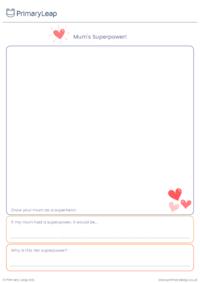
This fun and engaging activity encourages children to imagine their mum as a superhero! Pupils will think creatively and write about what special "superpower" their mum has, such as giving the best hugs, making the tastiest meals, or always knowing how to cheer them up. They will also draw a picture of their mum as a superhero, using her special ability. This activity promotes creativity, writing skills, and appreciation for mums.

This fun and engaging Mother's Day worksheet helps children express their appreciation for their mom by completing thoughtful sentence starters. From sharing favourite memories to expressing love and gratitude, this activity encourages creativity, personal reflection, and early writing skills. Perfect for classrooms or at-home learning!
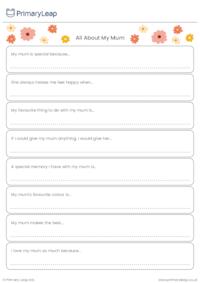
This engaging Mother's Day worksheet encourages children to reflect on and express their love for their mum. With sentence starters like "My mum is special because..." and "A special memory I have with my mum is...", children can complete each prompt with their own thoughts and experiences. A great way to promote gratitude, writing skills, and creativity while celebrating mums!

This fun and engaging Mother’s Day worksheet encourages children to celebrate their mom by writing and drawing. Students will fill in their mom’s name, draw a picture of her, and complete a sentence explaining why their mom is the best. This activity promotes creativity, fine motor skills, and emotional expression while celebrating a special day. Ideal for early years and KS1 learners.

This engaging Mother's Day activity encourages children to celebrate their mum by drawing a picture of her and writing about why she is special. Perfect for Early Years and KS1, this worksheet helps develop creativity, fine motor skills, and early writing skills while allowing children to express their love and appreciation.

This fun and engaging maze activity is perfect for Early Years and KS1 students. Children will develop their problem-solving and fine motor skills as they help the baby bird find its way through the maze to reach its mother. This simple yet enjoyable Mother's Day-themed worksheet is a great way to build logical thinking while celebrating the special bond between a mother and child.
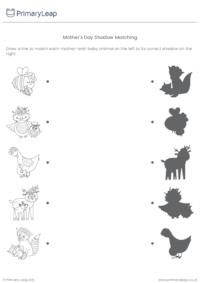
This fun and engaging shadow-matching activity is perfect for Early Years and KS1 students. Children will develop their visual recognition and problem-solving skills by matching each mother-and-baby animal to its correct shadow. This worksheet is a great way to celebrate Mother's Day while reinforcing early cognitive skills.

This worksheet features a flower pot with a "Happy Mother's Day!" tag for children to colour. Below the image, there is space for children to write a short message to their mum. This activity encourages creativity and writing practice while celebrating Mother's Day.

This fun and creative colouring page celebrates all the super mums out there! Children can colour in this superhero mum and personalise it to look like their own mother. This activity is perfect for Mother’s Day, encouraging children to express appreciation for their mum’s strength and kindness. Great for developing fine motor skills and creativity!
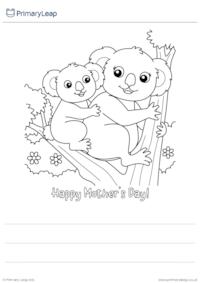
Celebrate Mother's Day with this adorable koala-themed writing and colouring activity! Children can colour in the sweet mother and baby koala and use the space provided to write a special message for their mum. They might write about why they love their mum, a favourite memory, or a thank-you note. This activity helps develop early writing skills and encourages creativity.

This delightful worksheet features a mother and baby fox, perfect for a Mother's Day-themed creative writing and colouring activity. Children can use the space provided to write a short story, a thank-you note to their mum, or describe a special moment shared with their mother. This activity promotes creativity, handwriting practice, and fine motor skills.
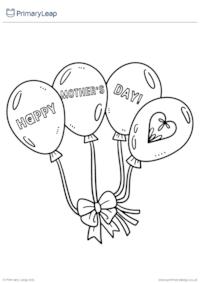
This fun and festive colouring page features a cheerful bunch of balloons with a "Happy Mother's Day" message. Perfect for children to personalise with their favourite colours and give as a heartfelt gift to their mum. This activity encourages creativity and fine motor skills while celebrating the special day.
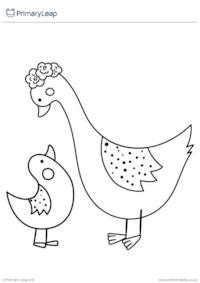
Celebrate Mother's Day with this adorable colouring page featuring a mother goose and her baby. This simple yet engaging activity is perfect for young learners to practise fine motor skills while expressing creativity. Encourage children to use bright colours and discuss the special bond between mothers and their little ones.

This St. Patrick’s Day creative writing activity encourages KS2 pupils to imagine life as a leprechaun and write a fun and imaginative diary entry. Students will explore their creativity by describing a leprechaun’s adventures, secret hiding places, and the tricks they play to protect their pot of gold. This activity develops descriptive writing, storytelling skills, and character development while engaging with Irish folklore.A great resource for St. Patrick’s Day literacy lessons or a fun independent writing challenge!
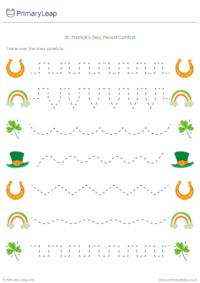
This St. Patrick’s Day-themed tracing worksheet is designed to help Early Years and KS1 children develop pencil control, fine motor skills, and pre-writing confidence. Pupils will trace different patterns, including zig-zags, waves, and steps, to follow the paths between fun St. Patrick’s Day images like shamrocks, leprechaun hats, horseshoes, and rainbows.This activity supports:Early pencil control for handwriting developmentHand-eye coordination through pattern tracingPreparation for letter formation by practising different strokesPerfect for classroom learning, home activities, and St. Patrick’s Day-themed handwriting practice, this worksheet makes early writing skills engaging and fun!

This St. Patrick’s Day pencil control worksheet is designed to help Early Years and KS1 children develop their fine motor skills and hand-eye coordination. Pupils will carefully trace along the dashed lines to reach the fun St. Patrick’s Day-themed images, improving their pre-writing and handwriting skills.This activity supports:Early pencil control for developing writing readinessHand-eye coordination through controlled tracingEngagement with themed learning in a fun and interactive wayPerfect for classroom learning, home activities, or independent practice, this worksheet makes pre-writing exercises more engaging with St. Patrick’s Day symbols like rainbows, shamrocks, and leprechaun hats.

This St. Patrick’s Day Cloze Activity is a fun and educational way for KS2 students to learn about the history, traditions, and legends of St. Patrick’s Day. Pupils will read a short passage and fill in the blanks using the provided word bank, reinforcing reading comprehension, vocabulary, and historical knowledge.This activity supports:Reading comprehension by encouraging students to engage with the textVocabulary building with words related to Irish culture and traditionsCritical thinking skills as students identify the correct words to complete the sentencesThis worksheet is ideal for classroom lessons, independent practice, and St. Patrick’s Day-themed learning activities.
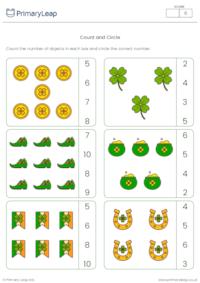
This St. Patrick’s Day counting activity is a fun and interactive way for Early Years and KS1 pupils to develop their counting and number recognition skills. Children will count the St. Patrick’s Day-themed objects, such as gold coins, shamrocks, and leprechaun hats, and then circle the correct number from the multiple-choice options.This activity supports:Early numeracy skills by reinforcing counting and number identificationFine motor skills as children circle the correct answersEngagement with themed learning through bright, engaging imagesPerfect for classroom activities, home learning, or independent practice, this printable worksheet makes maths fun while celebrating St. Patrick’s Day.

This St. Patrick’s Day word search is a fun and engaging activity designed for KS1 and KS2 pupils to reinforce spelling, word recognition, and pattern-finding skills. Featuring 10 themed words related to Irish traditions, myths, and celebrations, this puzzle helps children build their vocabulary while enjoying a holiday-themed literacy challenge.This worksheet supports:Spelling and vocabulary development through themed wordsProblem-solving skills by finding words in different directionsEngagement with cultural traditions linked to St. Patrick’s DayIdeal for classroom activities, home learning, or independent practice, this printable word search makes learning fun while celebrating Irish heritage and traditions.
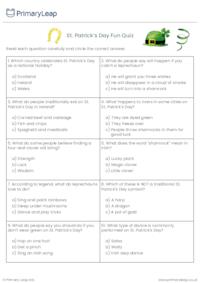
This KS2 multiple-choice quiz is a fun and engaging way for pupils to test their knowledge of St. Patrick’s Day myths, symbols, and traditions. Covering topics such as leprechauns, Irish legends, and traditional celebrations, this activity encourages pupils to think critically while learning about cultural folklore.Perfect for classroom learning, group quizzes, or independent practice, this printable worksheet helps pupils build their understanding of Irish traditions in an interactive way.

This KS2 reading comprehension worksheet introduces children to the legend of St. Patrick, the patron saint of Ireland. The passage provides key facts about his life, including how he was captured as a slave, his role as a Christian missionary, and famous legends associated with him, such as driving the snakes out of Ireland and using a shamrock to explain the Holy Trinity.Kids will:Develop reading comprehension skills by answering questions based on the textImprove knowledge of historical and cultural traditions related to St. Patrick’s DayEngage in creative writing by completing a diary entry challengeThis printable worksheet is perfect for classroom use, homework, or independent learning, helping pupils strengthen their literacy skills while exploring an important cultural celebration.

This St. Patrick’s Day-themed rhyming words activity is designed to support Early Years and KS1 learners in developing phonemic awareness, vocabulary recognition, and early reading skills. By identifying and matching the rhyming words, children reinforce their understanding of sound patterns in a fun and engaging way.This worksheet helps children:Recognise rhyming words and develop phonological awarenessImprove early reading skills by identifying word patternsEnhance vocabulary building with St. Patrick’s Day-themed wordsPerfect for classroom literacy lessons, home learning, and phonics practice, this printable worksheet makes language learning enjoyable while celebrating St. Patrick’s Day traditions.

This St. Patrick’s Day missing letters activity is a great way for Early Years and KS1 children to develop phonics skills, spelling awareness, and vocabulary recognition. By identifying the correct missing letter for each word, children reinforce their understanding of letter sounds and word structure while engaging with festive-themed imagery.This worksheet helps children:Strengthen phonics and letter recognitionImprove spelling skills by completing wordsEnhance vocabulary with familiar St. Patrick’s Day symbolsPerfect for classroom learning, home education, and literacy practice, this printable worksheet makes learning fun while celebrating St. Patrick’s Day traditions.
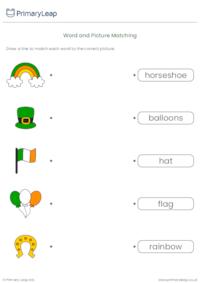
This St. Patrick’s Day-themed matching activity helps Early Years and KS1 children develop word recognition, vocabulary skills, and visual association. By matching each festive image with the correct word, children strengthen their understanding of key holiday symbols while improving their early literacy skills.This worksheet supports:Word recognition and vocabulary buildingFine motor skills through drawing or pointing activitiesCultural awareness by introducing traditional St. Patrick’s Day symbolsIdeal for classroom activities, home learning, and early literacy development, this printable worksheet provides a fun and interactive way for children to engage with St. Patrick’s Day celebrations.

This St. Patrick’s Day handwriting and colouring worksheet is designed to help Early Years and KS1 children develop letter formation, fine motor skills, and cultural awareness. By tracing the word "leprechaun", children reinforce their early writing skills while learning about this iconic figure in Irish folklore.This worksheet helps children:Practise early handwriting skills by tracing lettersImprove fine motor control through careful writing and colouringLearn about cultural traditions by exploring the role of leprechauns in Irish mythologyIdeal for classroom activities, home learning, and early literacy development, this printable worksheet offers a fun and educational way for children to engage with St. Patrick’s Day traditions.

This St. Patrick’s Day handwriting and colouring worksheet supports Early Years and KS1 learners in developing their letter formation, fine motor skills, and cultural knowledge. By tracing the word "clover", children improve their handwriting while learning about this important Irish symbol.This worksheet helps children:Practise early handwriting skills by tracing lettersImprove fine motor control through writing and colouringUnderstand the cultural significance of the clover in Irish traditionsIdeal for classroom use, home learning, and early literacy development, this printable worksheet combines handwriting practice with engaging cultural learning for St. Patrick’s Day.

This St. Patrick’s Day handwriting and colouring worksheet introduces Early Years and KS1 children to letter formation, fine motor skills, and cultural traditions. By tracing the word "horseshoe", children develop their handwriting while learning about the symbol of luck in Irish folklore.This worksheet helps children:Practise handwriting skills with letter tracingEnhance fine motor development through controlled pencil movementsLearn about cultural symbols associated with good luck and St. Patrick’s DayIdeal for classroom learning, home education, and themed handwriting practice, this printable worksheet combines literacy development with cultural awareness in a fun and engaging way.

This St. Patrick’s Day handwriting and colouring worksheet is a fantastic resource for Early Years and KS1 children to develop letter formation, fine motor skills, and cultural awareness. By tracing the word "boot", young learners strengthen their early writing skills while exploring a traditional symbol of leprechauns and Irish folklore.This worksheet helps children:Practise early handwriting skills by tracing lettersImprove fine motor control through writing and colouringLearn about cultural symbols linked to St. Patrick’s DayIdeal for classroom use, home learning, and themed literacy lessons, this printable worksheet provides an engaging and educational way to celebrate St. Patrick’s Day traditions.

This St. Patrick’s Day handwriting and colouring worksheet helps Early Years and KS1 children develop letter formation, fine motor skills, and cultural awareness. By tracing the word "hat", young learners strengthen their handwriting while connecting to the tradition of leprechauns and Irish folklore.This resource supports:Early handwriting practise through tracing activitiesFine motor skill development for better pencil controlCultural learning by introducing the leprechaun’s hat as a St. Patrick’s Day symbolIdeal for classroom activities, home learning, and early literacy development, this printable worksheet provides an engaging way for children to learn while celebrating St. Patrick’s Day.

This St. Patrick’s Day handwriting and colouring worksheet is designed for Early Years and KS1 learners to develop their letter formation, fine motor skills, and cultural awareness. By tracing the word "flag", children enhance their early writing skills while learning about the importance of national symbols.This resource supports:Early handwriting practise and letter recognitionFine motor skill development through tracing and colouringCultural education by introducing the Irish flag and its meaningIdeal for classroom activities, home learning, and early literacy development, this downloadable worksheet is an engaging way for children to build confidence in writing while learning about St. Patrick’s Day traditions.

This St. Patrick’s Day-themed handwriting and colouring worksheet is designed for Early Years and KS1 learners to develop letter formation, fine motor skills, and hand-eye coordination. By tracing the word "shamrock", children enhance their early writing abilities while reinforcing letter recognition and pencil control.This resource can be used to:Support early handwriting practiseIntroduce St. Patrick’s Day vocabularyEncourage creativity through colouringPerfect for classroom activities, home learning, and early literacy development, this printable worksheet is an engaging way for children to build confidence in writing while exploring the cultural significance of the shamrock.

This St. Patrick’s Day tracing worksheet is designed to help Early Years and KS1 children develop fine motor skills and pencil control while learning about the symbolism of the shamrock in Irish culture. By carefully tracing the dotted lines and colouring in the shamrock, children can improve their hand-eye coordination in a fun and engaging way.Key learning benefits of this worksheet:Supports early writing and pre-handwriting skillsEncourages creativity and colour recognitionIntroduces cultural awareness through discussion on St. Patrick’s Day traditionsIdeal for classroom activities, home learning, and early years development, this downloadable worksheet is a great way to combine learning and creativity during St. Patrick’s Day celebrations.

This St. Patrick’s Day colouring worksheet introduces children to the symbolism of good luck through a traditional horseshoe surrounded by shamrocks. A fantastic resource for Early Years, KS1, and KS2, this activity supports fine motor skills, pencil control, and cultural awareness.Educators and parents can use this worksheet to:Teach the meaning of lucky symbols in Irish folkloreEncourage artistic creativity and pattern recognitionProvide a fun and engaging St. Patrick’s Day classroom or home activityThis downloadable worksheet is ideal for classroom learning, home education, and themed lesson plans, helping children develop an appreciation for Irish traditions while enjoying a creative task.

This educational colouring worksheet introduces children to traditional Irish folklore through a detailed illustration of a leprechaun’s shoe filled with gold coins and lucky shamrocks. Designed for Early Years, KS1, and KS2, this activity encourages fine motor skill development, hand-eye coordination, and cultural awareness.Educators and parents can integrate this worksheet into St. Patrick’s Day lessons to:Explore the legend of leprechauns and their connection to Irish mythsReinforce early pencil control and artistic creativityProvide a calm and engaging activity for young learnersThis downloadable resource is ideal for classroom use, homeschooling, and independent learning, supporting a fun and interactive approach to cultural education.

This St. Patrick’s Day-themed colouring worksheet introduces children to the symbolism of shamrocks in Irish culture, making it an excellent resource for Early Years, KS1, and KS2. Featuring a large four-leaf clover surrounded by smaller shamrocks, this activity encourages fine motor development, pattern recognition, and creativity.Educators and parents can use this resource to:Support hand-eye coordination and pencil controlReinforce cultural awareness through discussion on the significance of shamrocks in Irish traditionsEncourage individual expression through creative colouringThis downloadable worksheet is ideal for classroom activities, home learning, and holiday-themed lessons, providing a fun and engaging way for children to celebrate St. Patrick’s Day while reinforcing key early learning skills.

Add a touch of St. Patrick’s Day magic with this charming leprechaun gnome holding a lucky shamrock. This unique colouring page is perfect for Early Years, KS1, and KS2 children, offering a fun and creative way to celebrate Irish traditions.Why this worksheet is great:Encourages fine motor skills and pencil controlIntroduces Irish folklore and holiday symbolsProvides a calming and engaging activity for the classroom or homeThis printable St. Patrick’s Day worksheet is ideal for teachers, parents, and homeschoolers looking for festive and engaging activities. Whether part of a holiday lesson, a craft session, or just a fun way to celebrate, this colouring page is sure to bring some good luck and creativity.

Bring some St. Patrick’s Day charm into the classroom or home with this adorable owl dressed as a leprechaun, sitting on a pot of gold under the night sky. This delightful colouring page offers a fun twist on traditional Irish folklore, making it perfect for Early Years, KS1, and KS2 children to explore their creativity.This engaging worksheet is great for:Encouraging imaginative colouring and artistic expressionHelping develop pencil control and fine motor skillsAdding a magical and festive element to St. Patrick’s Day lessonsWhether used in the classroom, at home, or in a homeschooling setting, this printable St. Patrick’s Day colouring page is a great way to celebrate Irish culture in a fun and engaging way. Just print, grab some crayons, and let the creativity take flight.

Celebrate St. Patrick’s Day with this fun colouring page featuring a cheerful leprechaun sitting on a pot of gold. Perfect for Early Years, KS1, and KS2, this engaging activity encourages children to get creative while learning about Irish traditions.This worksheet helps children:Improve fine motor skills and pencil controlExplore colour recognition and artistic expressionEnjoy a fun and relaxing holiday-themed activityIdeal for teachers, parents, and homeschoolers, this printable St. Patrick’s Day worksheet is a great addition to festive classroom activities, home learning, or creative play. Simply print and let the colouring fun begin.




Check out our ready-to-use Themed worksheets that can be used in the classroom or at home. Simply download or print and watch your child’s confidence grow with our easy to follow Themed printables.

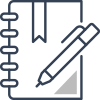
One of the best things about printable worksheets is that they make learning fun and easy. Explore our educational resources based on Themed and keep your children learning through these fun and engaging exercises.


Our Themed printable worksheets are designed for progressive learning. Our engaging content enables a child to learn at their own speed and gain confidence quickly. When we help a child believe in themselves, we empower them for life.


Printable worksheets are a great way to enhance creativity and improve a child’s knowledge. Help your child learn more about Themed with this great selection of worksheets designed to help children succeed.
An email has been sent to your account please activate your account to continue.

PrimaryLeap has introduced a new interactive learning platform and would like to offer you a completely Free Upgrade.
We understand that you may only want to use our services for worksheets and may not want to upgrade your account.
But if you are interested in trying out our new services then you're just a click away.
An email has been sent to your account please activate your account to continue.
You've answered
and have 2 Questions remaining
Import multiple students information through a CSV File. Browse or drag .CSV file below.